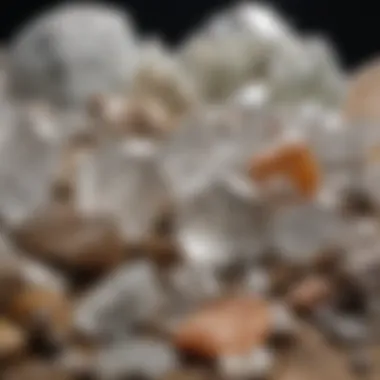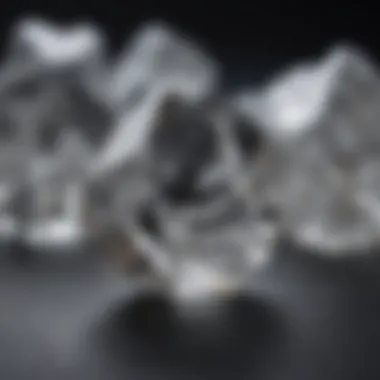Understanding the Value of Quartz: An In-Depth Analysis


Intro
The world of quartz is vast and intricate, reflecting not only the geological processes behind its formation but also the economic factors that govern its valuation. Quartz, abundant and diverse, holds a prominent place in the realm of collectibles, particularly among rock and fossil enthusiasts. Understanding its value requires an in-depth look at various aspects, including its types, qualities, sourcing locations, and current market trends. This foundation allows collectors and enthusiasts to navigate the complexities of buying, selling, and appreciating quartz specimens effectively.
History and Origins
Overview of Collectibles, Rocks, and Fossils
Quartz has long captivated the attention of collectors. Its varied appearance and durable structure make it a sought-after specimen. Collectible rocks and fossils tell a story of Earth's history, providing a tangible connection to the past. Quartz crystals, for instance, can form in different environments, resulting in unique specimens that range in color, clarity, and size. From geological formations to human-made artifacts, quartz transcends mere collection; it embodies the science and art of geology.
Historical Significance and Cultural Impact
Throughout history, quartz has played a significant role in various cultures. Many ancient civilizations valued quartz as a tool for both practical and spiritual purposes. For instance, Clear Quartz has often been associated with clarity of thought and energy amplification. Cultures believed that quartz could heal and protect. The usage of quartz in jewelry and rituals highlights its enduring significance.
Quartz’s historical applications extend into modern technologies as well, with its piezoelectric properties making it essential in electronics and watches. This diverse history enriches its current value in both the collector's market and practical applications.
Identification and Classification
Guide to Identifying Rocks and Fossils
Identifying quartz can seem daunting due to its many variations. However, with careful observation, collectors can distinguish between types. Key identifying features include:
- Crystal structure: Quartz commonly forms in hexagonal crystals.
- Color variations: Factors such as impurities change its appearance – for example, Amethyst is the violet variety of quartz.
- Transparency: Pure quartz can be transparent, while others might be cloudy or opaque.
Understanding these characteristics is crucial in assessing the quality and provenance of quartz specimens.
Common Types and Variations
Collectors encounter several common types of quartz, each with its unique appeal:
- Clear Quartz: Often regarded as the most basic yet versatile variety.
- Amethyst: A purple variant valued for its color and metaphysical properties.
- Citrine: Known for its yellow hue, often associated with abundance.
- Rose Quartz: This pink form is cherished for its appearance and associations with love.
These types illustrate the broad spectrum of quartz available for collectors. Awareness of individual characteristics aids in making informed purchasing decisions.
"Quartz is more than a mere stone; it's a window to Earth’s geological narrative."
The nuances in quartz valuation are influenced not just by type and clarity, but also by geographic sourcing and market trends. Collectors must stay informed about these factors for successful engagement in the quartz market.
Foreword to Quartz
Quartz is more than just a beautiful mineral found in nature; it holds significant value both in practical applications and among collectors. Understanding quartz is essential for both enthusiasts and professionals dealing with this versatile crystal. The importance of this section lies in setting the stage for deeper exploration into the various aspects surrounding quartz valuation. Grasping its definition, historical impact, and its place in human culture can provide insights into why quartz is sought after today.
Learning the basics will equip readers with the foundational knowledge necessary to navigate the nuances of quartz valuation. This includes examining not just the physical properties of quartz but also its cultural relevance throughout history. As this article unfolds, collectors will benefit from understanding what makes quartz unique and how it can influence its perceived value in the market.
Defining Quartz
Quartz is a mineral composed primarily of silicon dioxide. This compound is common in Earth’s crust and appears in various forms, with crystalline shapes that can be strikingly beautiful. It is typically colorless or white, but it can take on a spectrum of colors due to impurities. For example, amethyst is a purple variety of quartz, while citrine appears golden-yellow.
Quartz has a hardness rating of 7 on the Mohs scale, which indicates its durability. This characteristic makes it not only an attractive collectible but also a material used in numerous industries, including technology, construction, and jewelry production. Its piezoelectric properties allow quartz to generate an electric charge under mechanical stress, making it vital in electronic devices like watches and computers.
Historical Significance
Throughout history, quartz has captivated human interest. Ancient civilizations revered quartz for its mystical properties, often using it in rituals and as talismans. In many cultures, quartz has symbolism associated with clarity and spiritual insight. For instance, in ancient Egypt, it was frequently used to create amulets and tools. This historical context plays a significant role in how quartz is valued and perceived today.
Moreover, during the Stone Age, quartz served as one of the primary materials for tool-making. It aided our ancestors in survival and has been an integral part of human development. As civilizations evolved, so did the understanding and application of quartz. The historical significance of quartz enriches its value, making it a preferred collectible among enthusiasts.
In examining these factors, it becomes clear that the appreciation for quartz extends far beyond its aesthetic appeal. Understanding its definition and historical context lays the groundwork for deeper analysis in the following sections.


The Various Types of Quartz
Understanding the various types of quartz is essential for collectors and investors alike. Each type carries unique characteristics that influence its aesthetic appeal and, ultimately, its market value. The differentiation among quartz varieties lies not only in their visual attributes but also in their geological significance and historical context. Recognizing these nuances allows collectors to make informed decisions about acquisition and valuation.
Common Quartz Varieties
Common varieties of quartz encompass those often encountered in the market. These include, but are not limited to:
- Clear Quartz: This is the most recognizable form, known for its clarity and versatility. It is often used in jewelry and as a healing crystal.
- Amethyst: A purple variant of quartz, amethyst is highly sought after for its colors and purported metaphysical properties. Its richness in hue often correlates with higher value.
- Citrine: Characterized by its golden-yellow color, citrine is not just visually appealing; it is also associated with prosperity and energy. Natural citrine is less common and therefore can fetch a higher price.
- Rose Quartz: This pink variant is often utilized in decorative pieces and is believed to promote love and healing. Its softness in appearance appeals to many collectors.
- Smoky Quartz: With its brown to black tones, smoky quartz exhibits a distinctive look. This variety is also appreciated for its grounding energy.
These common varieties form the backbone of quartz appreciation and collection. Each type offers unique opportunities not just for aesthetic enjoyment but also for investment.
Rare Forms of Quartz
On the other hand, rare forms of quartz can present unique challenges and opportunities in the quartz market. These are typically less accessible and can significantly appreciate in value. Examples include:
- Ametrine: A natural hybrid of amethyst and citrine, ametrine features distinct zones of purple and yellow. Its rarity makes it highly coveted among serious collectors.
- Quartz Crystals with Inclusions: Inclusions such as rutile or tourmaline within quartz can greatly enhance the stone's beauty. These unique characteristics often lead to higher valuations due to their striking appearances.
- Tangerine Quartz: This variety is known for its unique orange coloration, which can be attributed to iron oxide inclusions. It is relatively uncommon, increasing its desirability.
- Heliodor Quartz: A rare yellow to yellow-green variety, heliodor can be difficult to find. Its resemblance to beryl, combined with its quartz properties, produces interest among collectors.
"Each type of quartz, from the faceted and familiar to the obscure and rare, contributes to a layered understanding of value in this collectable realm."
Recognizing both common and rare forms of quartz can enhance appreciation and foster strategic collecting. Being aware of these distinctions not only enriches one’s collection experience but also fosters informed investment strategies.
Factors Influencing Quartz Value
The valuation of quartz is a dynamic process influenced by various factors. Knowing these factors enables collectors and enthusiasts to appreciate the nuances of each specimen. This section delves into three crucial elements: quality and clarity, color variations and rarity, and geological location. Understanding these aspects helps in assessing both monetary and intrinsic value of quartz.
Quality and Clarity
Quality and clarity are fundamental in determining the value of quartz. High-quality quartz exhibits better clarity, with fewer inclusions and blemishes. Collectors often seek quartz that appears clear and transparent, as it allows light to pass through more freely. The absence of significant flaws or distortions can dramatically enhance the visual appeal of the crystal, making it more desirable to buyers.
In terms of specific characteristics, factors such as surface luster and cut also come into play. A well-polished quartz that reflects light beautifully can command a higher price. Additionally, the grading system for gemstones often evaluates clarity on a scale. Higher clarity grades correlate with higher value.
Color Variations and Rarity
Color can significantly impact quartz's value. While colorless quartz is abundant, colored varieties like amethyst, citrine, and rose quartz draw more interest. These varieties display unique hues that enhance their desirability. The intensity and uniformity of color can also influence pricing. For example, deep purple amethyst is more sought after compared to lighter shades.
Rarity plays an important role in quartz valuation. Rare colors and formations command premium prices. For instance, the price of pink quartz can increase if it comes from a rare deposit. Collectors are willing to pay more for unusual specimens or those that display unique patterns or formations.
"The rarity of a quartz variety can elevate its market value well beyond the typical ranges seen in common types."
Geological Location
The geological location where quartz is sourced profoundly affects its value. Certain regions are known for producing quartz of superior quality or unique characteristics. For instance, Brazilian quartz is esteemed for its clarity and size, while Madagascar quartz exhibits distinct colors often not found elsewhere.
Geographies with rich deposits often yield quartz that is also high in aesthetic appeal. Collectors frequently seek pieces from specific mines or areas known for exceptional specimens. Collectively, the historical significance of the locality can add sentimental value to a piece, further increasing its valuation.
Understanding these factors illuminates the complexities of quartz pricing. Recognizing the interplay between quality, color, rarity, and location provides valuable insights for both new and experienced collectors.
Market Trends and Pricing
Understanding the market trends and pricing of quartz is crucial for collectors and enthusiasts. These trends can significantly influence the value of quartz specimens. Investors and collectors alike need to be aware of how fluctuations in supply and demand, seasonal trends, and consumer preferences impact pricing. Evaluating these factors enables informed decisions when acquiring or selling quartz, potentially maximizing investment returns.
Current Market Analysis
The current market for quartz has seen dynamic shifts in recent years. Factors such as economic conditions, technological advancements, and global demand for both decorative and industrial uses play a role in shaping current prices. The rise of eco-friendly products has also heightened interest in natural stones, including quartz.
Factors contributing to the current market include:
- Geographic Influence: Certain regions known for high-quality quartz, such as Brazil and Madagascar, have seen increased prices due to limited availability and high demand.
- Digital Marketplaces: The growth of online trading platforms has expanded the purchasing options for collectors. Buyers now have access to a broader variety of quartz at different price points.
- Craft and Home Decor Trends: The integration of quartz into home design has surged, with quartz being favored for countertops and decor pieces. This trend drives up demand and prices in the decorative segment.


Enthusiasts should stay informed about market trends by regularly checking reputable sources and participating in online communities where discussions about quartz findings and prices occur.
Historical Pricing Data
Historical pricing data adds valuable context to the current market analysis. A thorough review of past prices reveals patterns that can often predict future trends. For example, over the past decade, the value of quartz has seen significant increases. This growth can be attributed to multiple factors such as the enhanced appreciation for collectible minerals and the growing popularity of holistic health practices that utilize crystals.
Here are some points to consider regarding historical pricing:
- Price Stability: Historically, quartz has maintained a relatively stable price compared to more volatile gemstones. This stability can provide confidence for long-term investment.
- Impact of Events: Market prices may rise or fall due to global events, such as economic crises or changes in trade policies. Tracking these events helps collectors anticipate shifts in value.
- Evolution of Demand: The types of quartz that have been popular in the past can influence current prices. For example, the demand for rose quartz has surged in recent years due to its association with emotional healing, which subsequently raises its price.
"Analyzing historical pricing data empowers quartz collectors to make educated decisions while navigating the market's complexities."
Evaluating Your Quartz Collection
Evaluating your quartz collection is an essential step for any serious collector or investor. This process not only helps in assessing the current worth of your pieces but also provides insight into their historical significance and market trends. Understanding the value of each specimen allows collectors to make informed decisions regarding sales or trades. Moreover, wearing the ability to readily evaluate these items adds security to your investments and fosters a deeper appreciation for the crystals themselves.
A comprehensive evaluation of your quartz collection involves various elements such as condition assessment and appraisal techniques. Each of these components plays a pivotal role in determining the overall market value of your specimens while allowing you to identify potential areas for improvement.
Condition Assessment
Condition assessment is the first step in evaluating quartz specimens. This involves a thorough examination of each piece to determine its physical state. Collectors need to consider several factors that contribute to a quartz's overall condition:
- Clarity: The presence of inclusions or cloudiness can affect a quartz's aesthetic appeal and value.
- Cracks and Chips: Surface damage diminishes the crystal's worth. A careful visual inspection can reveal such faults.
- Color Saturation: Variations in brightness or hue could indicate treatment or natural variations that influence value.
Moreover, documenting the condition of your pieces is equally important for future reference or potential sales. Photographs taken from multiple angles along with detailed notes can provide an accurate record. In some cases, restoration may be possible. However, accomplished restoration often requires professional skills, which can also influence value negatively if not performed correctly. Therefore, it is prudent for collectors to weigh the costs and benefits of restoration carefully.
Appraisal Techniques
Appraising your quartz collection is a structured process that can yield a clearer understanding of each specimen��’s market value. Here are some techniques used for effective appraisal:
- Professional Appraisal: Engaging a gemologist or a certified appraiser can give you an accurate evaluation based on their expertise.
- Market Research: Analyzing current market trends and historical sales data can provide benchmarks for pricing. Resources like en.wikipedia.org and britannica.com offer basic information about quartz types and their values.
- Competitive Analysis: Observing similar items available for sale on platforms such as reddit.com or facebook.com can also help you discern the value range.
Selling and Trading Quartz
Selling and trading quartz can be a rewarding endeavor for collectors. Understanding the dynamics of the market allows for informed decisions, whether you want to sell or trade your specimens. This section will cover the critical elements of identifying potential buyers and strategies for negotiation.
Identifying Buyers
Finding the right buyers is essential for successful transactions in the quartz market. Different types of buyers have varying needs and preferences. Collectors, for instance, may look for unique pieces to enhance their collections, while dealers might seek stock for their retail operations.
Some effective ways to identify potential buyers include:
- Online Marketplaces: Websites like eBay, Etsy, or specialized platforms like MineralAuctions provide venues to reach a broad audience.
- Collector Communities: Engaging in communities, such as those on Reddit or Facebook groups dedicated to rock and mineral collectors, can help in finding buyers who appreciate your quartz.
- Local Gem Shows: Attending gem and mineral shows is an excellent opportunity to meet face-to-face with potential buyers, allowing for direct interaction.
- Social Media: Platforms like Instagram can highlight beautiful specimens, drawing attention from collectors.
Being proactive in these channels can increase your chances of a successful sale.
Negotiation Strategies
Negotiation is a crucial aspect that can significantly affect the outcome of sales or trades. Establishing fair pricing, being aware of the market trends, and communicating effectively are vital components of a successful negotiation process.
Here are some effective strategies to employ:
- Know Your Worth: Understand the value of your quartz based on quality, clarity, and market trends. This knowledge gives you a solid baseline for negotiation.
- Open with Flexibility: Begin discussions with an open mind. Being flexible allows room for compromise, which can lead to a satisfactory conclusion for both parties.
- Build Rapport: Forming a good relationship with the buyer can influence negotiations positively. Customers are often more inclined to buy from someone they trust.
- Be Prepared to Walk Away: Sometimes, negotiations do not go in your favor. It is essential to have the confidence to walk away if the offer does not meet your expectations. This practice shows that you value your quartz and are not desperate for a sale.
"Negotiation is not just about getting the best price but also creating a win-win situation for both seller and buyer."
By implementing these strategies, one can increase the likelihood of achieving successful sales or trades in the quartz market.
Caring for Quartz Crystals


Caring for quartz crystals is vital for maintaining their beauty and ensuring their long-term value. Quartz, known for its durability and vibrant appearance, can still suffer from neglect, exposure to harsh conditions, or improper handling. Proper care extends the life of the specimen and keeps it in prime condition for collectors or as an investment piece.
Benefits of Caring for Quartz Crystals
Caring for quartz involves regular maintenance and thoughtful handling. When done correctly, it can significantly enhance the visual appeal and market value of the crystal. Well-maintained quartz is not only more attractive but can also fetch higher prices in future transactions. Moreover, understanding effective care techniques can help collectors develop a deeper appreciation for their specimens and foster a lasting relationship with their collection.
Considerations about Caring for Quartz Crystals
It is important to note that different environments can affect quartz. Pollutants, humidity, and physical damage can reduce a crystal's allure and potentially its value. By employing effective cleaning and storage techniques, collectors can safeguard their specimens against deterioration caused by these factors.
Cleaning Techniques
Regular cleaning is a fundamental aspect of quartz maintenance. When it comes to cleaning quartz crystals, the method employed depends on the type of impurities present and the specific variety of quartz.
- Gentle soap and water: For most common quartz varieties, a gentle soap solution is effective. Mix a small amount of liquid soap with warm water, using a soft brush or cloth to gently scrub the surface. Ensure that no soap remains, as residue can affect the appearance over time.
- Ultrasonic cleaners: These devices can be useful for cleaning quartz, provided the stone does not have fragile inclusions. Ultrasonic cleaners operate by sending high-frequency sound waves through a cleaning solution, effectively removing dirt and grime from all surfaces.
- Avoid harsh chemicals: Always stay away from bleach or acid-based cleaners, as they can damage the crystal's surface, compromise its integrity, and diminish its value.
Regular cleaning not only keeps quartz specimens looking their best but also prepares them for display or sale.
"Properly cleaned and cared-for quartz can significantly increase in both aesthetic appeal and market value."
Proper Storage Methods
Proper storage of quartz crystals is essential in preserving their condition. When quartz is stored incorrectly, it can lead to scratches, chips, or alterations in clarity, which all can impact its value.
- Use soft storage materials: Always ensure that quartz specimens are stored in soft pouches, bubble wrap, or padded boxes to avoid damage from contact with harder surfaces or other stones.
- Control environmental conditions: Keep crystals in a stable environment, away from extreme temperatures and humidity. It is best to store quartz in a temperature-controlled area, avoiding basements where moisture is high or attics where heat can build up.
- Avoid stacking: When possible, refrain from stacking quartz pieces on top of each other. Instead, allow each piece its space to avoid friction that might cause scratches or chips.
- Display with care: If displaying quartz, use sturdy display cases to prevent accidental falls or exposure to dust, which can obscure the stone's natural beauty.
Investing in Quartz
Investing in quartz has gained traction among collectors and investors alike, owing to its diverse applications and intrinsic appeal. This section outlines the importance of understanding the various facets of investing in quartz. Knowledge in this area enables collectors to make informed decisions, ensuring they maximize the potential of their investments. When done correctly, investing in quartz can yield substantial returns, all while appealing to one's aesthetic sensibilities and passion for geology.
Quartz is not just an attractive mineral; it represents a significant asset class. Its value can be influenced by many factors such as quality, clarity, origin, and market trends. An appreciation of these elements can enhance one's collection and financial portfolio.
The benefits of investing in quartz are manifold:
- Diverse Range: From amethyst to citrine, squat offers investors a multitude of choices.
- Growing Market: The interest in gemstones and minerals is increasing, creating a robust market for quartz.
- Tangible Asset: Unlike stocks or bonds, quartz is a physical good, providing a sense of ownership and connection.
Long-term Investment Potential
Investing in quartz can be seen as a long-term strategy. Over time, the value of high-quality quartz can appreciate significantly. As with any investment, longevity relies on understanding market cycles and trends. With continuous advancements in technology, the mining and processing of quartz have also improved, resulting in better quality gemstones entering the market. This shift opens pathways for investment opportunities.
Many investors focus on rare or unique varieties, as their scarcity tends to drive demand. Moreover, quartz's versatility in various industries, including electronics and fashion, further solidifies its position as a reliable investment choice.
Risks and Considerations
While investing in quartz holds potential, it is essential to recognize the associated risks. Not every crystal will appreciate over time, and there are factors investors must assess:
- Market Volatility: The mineral market can be unpredictable, influenced by global economic conditions.
- Quality Assessment: Not all quartz is equal; misleading marketing can lead to overvaluation.
- Authenticity: Counterfeit quartz exists. Investors must rely on reputable sources to avoid pitfalls.
In summary, investing in quartz carries both opportunities and challenges. For those armed with knowledge and a solid strategy, the rewards can be gratifying.
Culmination
In concluding our exploration of quartz valuation, it is essential to reflect on the various elements that contribute to the overall worth of this mineral. The discussion has navigated through factors like type, quality, geographic sourcing, and evolving market trends. Each aspect plays a significant role in how collectors and investors assess the value of quartz specimens.
By recognizing the subtle differences amongst quartz varieties and being aware of the geological origins, individuals can make informed decisions. This education not only aids in evaluating personal collections but also influences potential buying and selling strategies.
Additionally, understanding current market trends alongside historical data offers a broader context for decision-making. This knowledge is particularly beneficial for rock and fossil collectors aiming to enhance their collections with valuable specimens.
"Knowledge of the specifics surrounding quartz can significantly inform your investment strategies."
Recap of Key Points
- Types and Varieties: Different types of quartz can hold varying degrees of value. For instance, amethyst and citrine often attract collectors due to their unique colors and formations.
- Factors Influencing Value: Quality and clarity are paramount. A clear quartz crystal is generally more valuable than one with inclusions, unless those inclusions are deemed unique.
- Market Trends: Staying updated on current market conditions and historical pricing data can assist collectors in identifying opportune moments for buying or selling.
- Appraisal Techniques: Understanding various appraisal methods will help ensure collectors receive a fair assessment of their quartz's value.
Final Thoughts on Quartz Valuation
As we finalize our examination of quartz valuation, it becomes clear that this subject is not merely academic. Instead, it has practical implications for collectors, investors, and enthusiasts alike. The value of quartz is multidimensional, influenced by external forces like market trends and personal preferences regarding aesthetics and rarity.
In making choices about quartz, collectors should remain vigilant and informed, recognizing that the landscape of quartz valuation is both dynamic and nuanced. Investing in quartz can be rewarding, but it requires due diligence and a willingness to adapt to shifting trends. Ultimately, this understanding of quartz and its valuation equips individuals with the necessary tools to enhance their engagement with this fascinating field.



